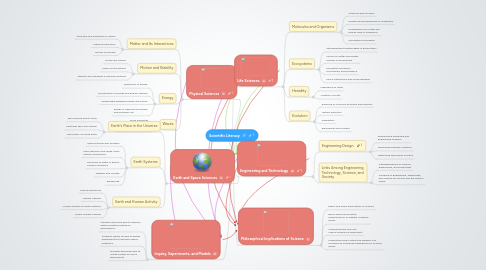
1. Physical Sciences
1.1. Matter and Its Interactions
1.1.1. Structure and Properties of Matter
1.1.2. Chemical Reactions
1.1.3. Nuclear Processes
1.2. Motion and Stability
1.2.1. Forces and Motion
1.2.2. Types of Interactions
1.2.3. Stability and Instability in Physical Systems
1.3. Energy
1.3.1. Definitions of Energy
1.3.2. Conservation of Energy and Energy Transfer
1.3.3. Relationship Between Energy and Forces
1.3.4. Energy in Chemical Processes and Everyday Life
1.4. Waves
1.4.1. Wave Properties
1.4.2. Electromagnetic Radiation
2. Earth and Space Sciences
2.1. Earth's Place in the Universe
2.1.1. The Universe and Its Stars
2.1.2. Earth and the Solar System
2.1.3. The History of Planet Earth
2.2. Earth Systems
2.2.1. Earth Materials and Systems
2.2.2. Plate Tectonics and Large-Scale System Interactions
2.2.3. The Roles of Water in Earth's Surface Processes
2.2.4. Weather and Climate
2.2.5. Biogeology
2.3. Earth and Human Activity
2.3.1. Natural Resources
2.3.2. Natural Hazards
2.3.3. Human Impacts on Earth Systems
2.3.4. Global Climate Change
3. Inquiry, Experiments, and Models
3.1. Students should be able to develop inquiry questions based on observations
3.2. Students should be able to design experiments to test their inquiry questions
3.3. Students should be able to create models for use in experiments
4. Life Sciences
4.1. Molecules and Organisms
4.1.1. Structure and Function
4.1.2. Growth and Development of Organisms
4.1.3. Organization for Matter and Energy Flow in Organisms
4.1.4. Information Processing
4.2. Ecosystems
4.2.1. Interdependent Relationships in Ecosystems
4.2.2. Cycles of Matter and Energy Transfer in Ecosystems
4.2.3. Ecosystem Dynamics, Functioning, and Resilience
4.2.4. Social Interactions and Group Behavior
4.3. Heredity
4.3.1. Inheritance of Traits
4.3.2. Variation of Traits
4.4. Evolution
4.4.1. Evidence of Common Ancestry and Diversity
4.4.2. Natural Selection
4.4.3. Adaptation
4.4.4. Biodiversity and Humans
5. Engineering and Technology
5.1. Engineering Design
5.1.1. Defining and Delimiting and Engineering Problem
5.1.2. Developing Possible Solutions
5.1.3. Optimizing the Design Solution
5.2. Links Among Engineering, Technology, Science, and Society
5.2.1. Interdependence of Science, Engineering, and Technology
5.2.2. Influence of Engineering, Technology, and Science on Society and the Natural World

